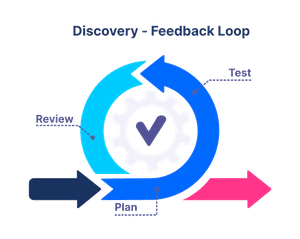Gathering user feedback is one of the most essential approaches to creating a product the users and market will love.
Fortunately, most of the product development methodologies allow for doing at early development stages – starting from your idea validation and ending with real-life testing of your MVP. What’s more, collecting customer feedback is a never-ending process for product teams since their preferences may change but your solution still has to be competitive.
In this article, we’ll take a look at tried and tested methods and feedback gathering and management tools to help you find out what users think about your product.
Contents
What is User Feedback?
User feedback is not a customer satisfaction survey or a user experience research. User feedback is any information – positive or negative experience – collected directly from users about their experience using our products or services. We collect this feedback via many different channels including, but not limited to, live chat, email, phone calls, and more.
We use user feedback to help us understand what we are doing well and where we can make improvements in our digital products. We take action based on the positive or negative user feedback we receive.
Why Is User Feedback Important?
Before starting to collect user feedback, may sure you have clarified the following parameters.
- Your goal. What exactly do you want to find out? It can be design aesthetics, usability, user engagement, market demand, users’ preferences, and so on.
- Your tools. Next, prepare a list of tools that will be helpful for reaching out to your customers and getting to know their opinions.
- Your metrics. As the last step, define the clear and measurable metrics that will allow you to conclude on achieving your goal.
Expand your knowledge, follow us for more!
How To Collect User Feedback
Start with finding out your customers’ impressions and opinions by using the following strategies.
1. Interviews, Polls, and User Surveys
There are several types of user feedback collection. The best way to get an answer is to ask a direct, simple question. Interviews, polls, and surveys are leading strategies for customer feedback gathering. However, you should be smart with these three approaches.
- Interviews are good at the idea validation stage. Since the answers to interview questions are difficult to predict, you may use the obtained insights in the next development stages.
- Surveys are good when you already have something to show your users but are still unsure what of the options work best. For example, you may use surveys at the stage of Proof of Concept and prototype testing.
- Polls, in turn, can be used for MVP testing. As well as interviews may enrich you with unexpected points of view.
To streamline the process of collecting user feedback following these approaches, you may various tools such as SurveyMonkey, Zoom, Typeform, etc. for getting to know your customers and their opinions.
2. Focus Groups
A focus group survey is a very powerful approach that can be used at the stage of your idea validation, Proof of Concept, prototype, and MVP testing.
The advantage of this method is the opportunity to get in touch with real users and find out their impressions firsthand. It also allows for getting valuable, actionable insights since you may ask your users to suggest the ideas that seem better for them and use this information in the next development stage.
3. User Forums
User forums like Reddit and Quora can also be useful resources for customer experiences. On these platforms, they often share their experiences and ask questions about how to use specific features. Make sure to use them to find out the ways your app works for its users and what pitfalls they may have.
Also, make use of the power of other social media to come up with a holistic picture and attract new customers. Most popular apps have social media profiles where they share engaging content and motivate users to write reviews and testimonials, ask questions and talk about use cases.
To get done with this task, use social listening tools that allow for tracking your brand mentions and evaluating users’ sentiments.
4. In-app User Feedback
This is quite an obvious tip, however, considering the number of negative reviews in directories where users can access your product, it may seem that very few product managers had a look at what is going on on their official pages. But in fact, the reviews of your users shared in official app markets should be the primary source of information for gathering their feedback and finding out the strong and weak points of the product.
Make sure to check these reviews quite frequently, and what’s more important, communicate with your users via official stores. It will contribute to building your brand loyalty. Even if there is negative user feedback, you still may show that it matters for the app creators, and report on the progress toward improving the flaw.
5. Analytics may also be a source of user feedback
Gathering your customers’ feedback would be useless without analysis and reporting. What’s more, the results you expect to get should be carefully tailored to your goals and metrics. For example, let’s suggest you have submitted a sponsored blog post. How will you evaluate the effectiveness of this venture?
There are several options:
- Monitor the number of users who jumped to your website after reading a post.
- Evaluate the number of likes and shares to get an impression of users’ engagement and the value they get.
- Track SEO results and monitor the position of the post on Google search results.
All of these metrics can state your efforts are paying off, however, each of them corresponds to different goals. Therefore, before you start the analytics, you should set it up so that you can see and evaluate only the most important parameters.
6. A/B testing
A/B testing is one of the best approaches to test user acceptance, engagement, journeys, and the decisions they made while using an app. This method is suitable when you are not sure how certain details will work. For example, your designers may argue about the color of the “Get Started” button, and the best way to find out whose idea is better is to test both of the options with your users.
In this case, you should also be quite clear with the thing you need to test, the result you want to get, and the success metric.
7. Ideas Portal
The ideas portal is one more method for getting customer feedback. It is especially useful at the first development stages when you need to brainstorm creative ideas but still be guided by your users’ preferences and expectations. An ideas portal is a perfect tool to gather some creative ideas, should those be UI/UX ideas, feature ideas, or anything else in one place, and let the users vote for the best choice.
However, don’t use an idea portal as the only tool for user feedback management. It may work well for the idea validation stage of product management, but use some more methods to make sure that the idea is winning.
However, don’t use an ideas portal as the only tool for getting user feedback. It may work well for the idea validation stage but use some more methods to make sure that the idea is winning.
8. Usability Tests
Testing your usability is one of the most important strategies after your MVP is launched. You may do it by mapping user stories with the help of StoriesOnBoard, and then find out whether the planned stories coincide with the ones your users follow.
Also, you may use HotJar to find out the behavior patterns of your users in real-time. The advantage of the tool is a top-notch visualization which allows for avoiding numbers-powered analytics and finding out how your users behave. Use both of these tools in conjunction with analytics to come up with a holistic picture and make sure that your app is on the right track.
4 tips to encourage actionable product feedback from users
Assuring a constant flow of product feedback is vital for so many reasons. You can gain valuable insight from the feedback of your users, build a community around the product and increase your credibility with potential customers at the same time. But how do you make sure that you’re not missing any worthy feedback channels? By following along with our list of the best ways to gather valuable product feedback. But first, let’s start with the basics.
Lean product roadmapping powered by product feedback
Actionable product feedback is an essential building block of lean product roadmapping. What concept do you build your lead startup around? Probably making small, incremental steps and getting market validation as fast as possible. As soon as you have a prototype or MVP ready, put it out there to see if it provides a solution to a real problem. This way you can test early on whether the feature or product is critical to solving a given problem.
No wonder “Release early, release often” is the motto of Product Managers. Having the first-mover advantage is a key factor of competitiveness today in product development. You can achieve that by
- developing quickly &
- building on the right idea, and solving real problems.
Doesn’t get leaner than the discovery-feedback loop
What if we take the speed of development out of the equation? The only variable we’re left with to optimize for is the idea. Think about it. If you can gather valuable product feedback on the idea without development, you can start the development phase with a much better understanding of several aspects. For example:

- How your users have been solving the given issue so far?
- Who needs to tackle the issue?
- What are the main pain points?
- Who are the other important stakeholders?
How can this be done?
Have some good mockups ready, a solid base of power users & some reliable channels to gather product feedback from. Show your planned features to your users. This way they can reflect on them before they are deployed.
Build a community to get more product feedback
Once you start getting in touch with your power users, early adopters, or champions, you can start building a beta user base. You’ll always be able to turn to this group of users before launching a new product or feature. Early adopters are aware that the beta version or a prototype has flaws. However, they’re usually so tech-savvy that they don’t mind occasional glitches.
This way, you’ll start building a community around your product. Power users exhibit high engagement, high responsiveness, and high loyalty if they see that their feedback was valued. A small, but solid follower base is essential to kickstart the hype when you come to the market with something new.
Which users to ask for feedback?
As for product feedback, your goal is to receive deep and actionable insights that will make your product better. This can come from all user groups, but it’s most likely to come from advocates or champions.
On the other hand, you can use feedback collection to deepen the relationship with your users and push them to the next level. That is to say, turn affluents and advocates into champions.
Expand your knowledge, follow us for more!
The 4 best ways to get actionable product feedback
1. In-app surveys
Generally, surveys are great for getting an idea about the magnitude of things and trends, since they provide mainly quantitative results as opposed to the qualitative nature of interviews. In-app surveys are a special subset of surveys that are meant to tackle low response rates by eliminating friction from the process. By keeping users in the app, in-app surveys solve two issues at the same time:
- you get valuable user feedback &
- you can increase the user’s time spent on the app.
The in-app survey can serve a variety of business areas from customer success to marketing, but the most common is product development. They work well for a variety of product feedback such as for validating feature ideas, rating existing features, identifying user pains, or asking for reviews. They can take various forms from a simple pop-up message asking how much you like a feature to custom solutions.

The best thing about in-app surveys…
… is that you can segment your audience well. Ask only users who have completed a certain step or who use a give integration to get a better answer rate and to make your questions more relevant!
Pro tip #1 : You can gather valuable insight from users who already have some experience with your app, are current subscribers, don’t target new users and users who have not used the app in a long time or are not regular users.
Pro tip #2 : People don’t like to type, make the questions as easy as possible, give people options whether those are multiple choice answers, numbers or emojis, that they can choose from if they want to answer quickly but also leave the option open for a longer answer. Having quantitative data makes it also significantly easier for you to summarise results.
Pro tip #3 : Be careful with multiple choice answers. Make sure that you’ve made it clear what the options actually mean. We need to make a confession here: this is a lesson we learnt from our own mistakes. When you provide answers to you audience, they might have a very different understanding of those options. For instance, we asked our users why they find StoriesOnBoard useful and gave them options like: a) high-level overview, b) better visibility on projects etc. It was only when we interviewed our power users that we found out that these mean something very different for everyone.
2. Out-of-app surveys
The truth is people find out-of-app surveys a hassle. Feedback requests per e-mail leading to third-party review sites seem like a waste of time. We’ve all been there, but the time can come when we desperately need the generosity of our users with their time to fill in these surveys.
What can we do to improve response rates of out-of-app surveys?
Create a process for them and benefit from quantity. Try to automatize the process so that users who complete a given step will be asked immediately to provide a review. Make sure that on completing that steps, they are ready to be asked to be surveyed.
Since the friction is quite high, users must leave the app or whatever they were doing, and make sure to always follow up with an email. This way users who were reluctant to break their workflows, but who would be willing to be surveyed otherwise, get another chance to give feedback. In your ask, be specific, don’t be afraid of asking but refrain from being too pushy.
Pro tip #4 : In case of out-of-app surveys, improve response rates by offering an incentive.-Don’t just expect your users to take valuable time to do work for you, give something in exchange even if it’s not a monetary incentive, do your best to provide some value in exchange.
3. Customer interviews
While in-app surveys work only with existing users, you may also find customer interviews with churned customers or the competitor’s customers useful. However, it’s slightly trickier to get hold of those interviewees.
When to use customer interviews in product research?
Anytime from the discovery stages through prototyping to upgrading. The best way is to turn it into a regular practice to assure the influx of continuous feedback on your product.

Who conducts user interviews?
Although customer interviews can be led by the Product Owner, in many cases they are done by a professional researcher or a specific lead role from the front lines. It’s best to have two people present for better understanding and also because one person can take notes while the other follows along with the conversation.
Regardless of who conducts the interview, the prep work needed to be done remains unchanged. Doing research on the customer before the interview and drafting a good script is a must.
Pro tip #5 : Decrease the friction of user interviews by setting a reasonable time frame. If you ask for a 30 minute interview instead of 90 minutes, customers will be more likely to agree to it. Be ready that you’ll have only that limited time frame and you’ll have to make the most of it, so always keep an eye on the questions. If you’re short on time, while your questions seem infinite, try to focus on identifying the pain points of the customer. That proves to be the information of the highest value in most cases.
4. Public roadmaps
Public roadmaps have been becoming more and more popular, but many companies are still reluctant to use them due to the fear of being accountable for everything up there. Making a promise means, however, that the team will have to deliver, incentivizing them to switch to a faster gear and become more productive.
When you weigh the pros and cons, try to dissect the customer’s perspective: they need to trust a tech company before making their business processes reliant on their product. Public roadmaps are a great way to boost transparency which is key for larger B2B, enterprise customers. If you’re not comfortable with putting everything up there, just make it a limited, highly curated version of your actual roadmap.

Still not convinced yet?
A huge advantage of public roadmaps is that they need low maintenance, they just keep running and gathering valuable product feedback in the background. Since you can only gather upvotes or comments, the depth of the feedback is fairly limited, but that shouldn’t be an issue at this stage. A deeper understanding can be supported by customer interviews.
Pro tip #6 : Whether you go for building a custom roadmap or using a roadmap tool, always opt for simplicity. Make sure visitors get what the idea is about and they can click on upvote in an instant.
Conclusion
Having user feedback is an essential step in lean development. This is the only way to make sure that your future solution will fit your users’ expectations and take a place under the sun in the market you are going to enter. Use the mix of the strategies above to lead your product along the path to success.
About the author: Diana is a journalist, freelance writer, and editor at Adsy. She has worked for many major publications, but she also ambitiously pursues challenging freelance projects. Her love for traveling motivates her to explore the world. Diana wants to inspire people to follow their dreams by sharing her experiences online.
